
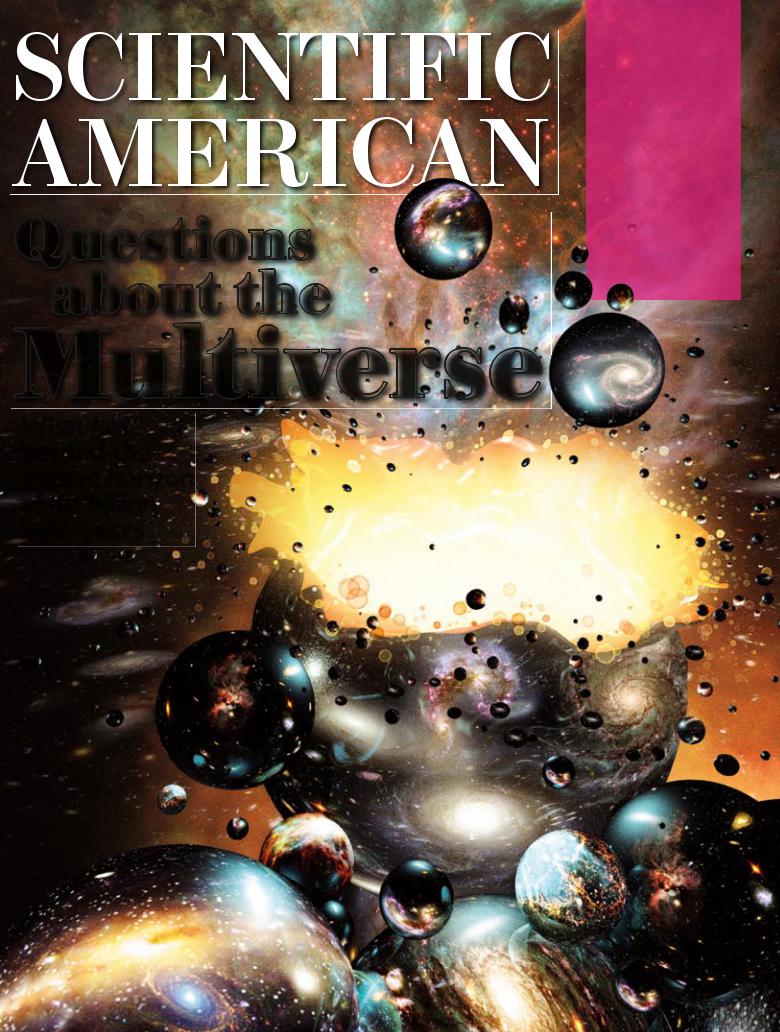
August 2011 ScientificAmerican.com
Questions about the
Multiverse
What lies beyond the cosmic horizon of 42 billion light-years
Energy
Biofuels’ False
Promise
Neuroscience
The Science
of Better
Learning
Evolution
Rise of
Longevity
© 2011 Scientific American
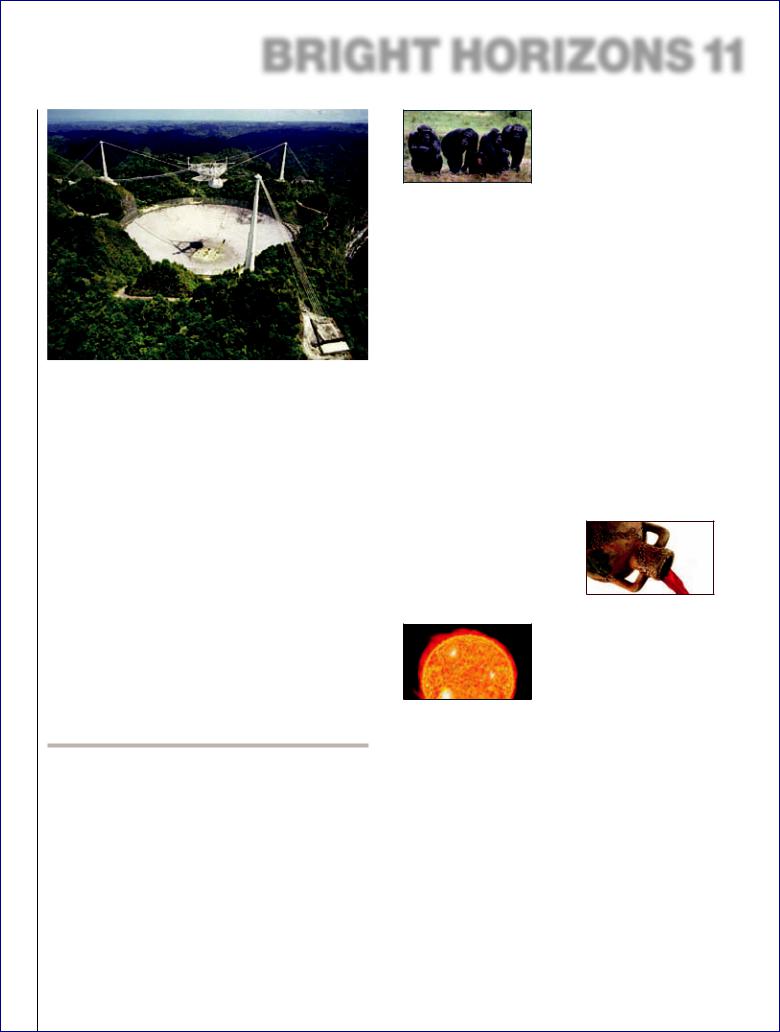
 BRIGHT HORIZONS11
BRIGHT HORIZONS11
JANUARY 14–21, 2012 EAST CARIBBEAN www.InsightCruises.com/sciam11
Arecibo Observatory
Exercise your science curiosity in the surprisingly suitable Caribbean. Cast off on Bright Horizons 11 and explore a slate of science topics inspired by the islands. Based on Holland America Line’s m.s. Eurodam, our community of science experts and science buffs head for tropical climes, January 14–21, 2012, round-trip Fort Lauderdale, Florida.
Take a cue from our island journey and delve into the form and function of flowers and plant evolution on islands with Dr. Spencer Barrett. Open a door to thought-provoking developments in primatology with Dr. Frans de Waal. Enjoy the fruit of crossdisciplinary work in bioarchaeology when Dr. Patrick McGovern details discoveries about ancient fermented beverages. Dr. Marc Davis guides us through physical cosmology and the latest on the search for exoplanets. Explore sun science and energy futures, and grasp “Einstein in a Nutshell” through Dr. Richard Wolfson’s sessions.
We’ll go behind the scenes at the Arecibo radio telescope on an optional excursion with briefings on the radio astronomy, planetary radar and climatology research there. Plus, we’ll boldly go where ordinary visitors are not permitted at the telescope, using the password “Scientific American”.
See what’s brewing in astrophysics and climatology, primatology, botany, and bioarchaeology. Add vivid colors and beautiful beaches, elegant dining and gracious service, sunsets and fun with friends, and you have the Bright Horizons 11 picture. Please join us! For full details, email concierge@insightcruises.com or call (650) 787-5665.
Cruise prices vary from $699 for an Interior Stateroom to $2,699 for a Deluxe Suite, per person. For those attending our program, there is a $1,475 fee. Government taxes, port fees, and InSight Cruises’ service charge are $183.80 per person. For more info please call 650-787-5665 or email us at Concierge@InSightCruises.com
CST# 2065380-40 ™Scientific American, Inc.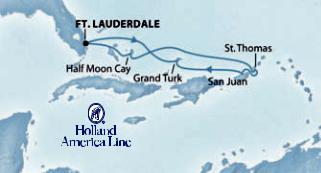
PRIMATOLOGY
Speaker: Frans B.M. de Waal, Ph.D.
A Darwinian View of the Moral
Emotions in Man and Animals
Thomas Huxley held that we are born nasty and selfish. Charles Darwin differed, believing in continuity between animals’social instincts and human morality. Learn how modern psychology and neuroscience support Darwin’s view. Join Dr. de Waal and review the evidence supporting the view that the building blocks of morality are older than humanity.
On the Possibility of Animal Empathy
Learn about expressions of empathy in animals. Dr. de Waal will present a “Russian doll” model of how animals perceive others. This model permits responses to be geared specifically to the other’s situation, thus increasing the effectiveness of sympathetic support, care, and reassurance, as observed in dolphins, apes, and elephants. Absorb primatology’s observations of emotionally mediated interactions, and explore the latest thinking on animal empathy.
What Primates Know About and Learn From Each Other
Primates live in complex societies in which they compete, try to become dominant, but also help friends and kin. We’ll take a look at recent experiments on the role of policing by high-ranking peacekeepers, how primates distinguish gender, and what primates learn from each other. Delve into the up and coming field of “cultural primatology” and find out about the surprising foundations of primate societies.
ASTROPHYSICS, ASTRONOMY,
AND RELATIVITY
Speakers: Richard Wolfson, Ph.D.,
Marc Davis, Ph.D.
Einstein in a Nutshell
Does it “take an Einstein to understand” Einstein’s ideas? No! Einstein’s theory of relativity is based on an idea so simple it can be stated in a single English sentence. From that simple idea follow conclusions that have revolutionized our notions of space, time, and causality. Learn how the seemingly bizarre and sometimes paradoxical results of relativity are logical consequences of the theory’s underlying simple principle.
The Search For Exoplanets
In the past decade research has shown that planets are very common to stars like our own. Take an in depth look at the major research being done by NASA’s Kepler spacecraft. Learn how the Kepler, Spitzer, and Hubble programs differ in their search for exoplanets.
Gravitational Lensing
A 1918 solar eclipse made Einstein a celebrity when it confirmed his prediction that the
sun can bend light, now called gravitational lensing. Dr. Marc Davis will present the basics on gravitational lenses, relate the discoveries they’ve facilitated and show some fabulous examples of this phenomenon.
Galaxies and the Clustering of Galaxies
Survey the cosmic terrain and the largescale structure of the universe. Get a handle on landmarks such as the Great Wall and the gigantic clusters of galaxies connected to each other by huge fi laments and voids. How did this structure originate? With Dr. Davis as your guide you’ll get a grasp of the surprising cosmography of the universe.
Why Does Our Universe Have a Beginning?
We know that the universe is 13.7 billion years old. Why is it that old? Why does it have a beginning? The best answer, Infl a- tion, is so convincing that all cosmologists believe in Inflation, in spite of its speculative nature. Learn about Inflation’s support and the alternative theories so you can enjoy the confi rmations and developments to come.
Wild Sun!
Our Sun seems a stable, reliable star, but actually seethes with activity. Violent eruptions send high-energy particles into interplanetary space. These solar storms damage satellites and disrupt communications and terrestrial power systems. New spacecraft offer an unprecedented look at our star’s activity. Explore new discoveries about the Sun and about the intimate link between Sun and Earth that recent imaging and technology advances have made possible.
THE ANCIENTS AND CHEMISTRY
Speaker: Patrick E. McGovern, Ph.D.
Uncorking The Past: The Quest For Wine, Beer, and Extreme Fermented Beverages
Drawing upon recent archaeological discoveries, molecular and DNA sleuthing, and the texts and art of long-forgotten peoples, you’ll take an in-depth look at the archaeological study of ancient fermented beverages, from residues on a potsherd
to laboratory analyses to commercial re-creations of ancient brews. You’ll gain a renewed appreciation of fermented beverages’ role in the world’s collective heritage.
Royal Purple: The Dye of Gods And kings
Enter a mythical past with Dr. Patrick McGovern, and explore the most valuable dye of antiquity, Royal Purple. The story is about chance discovery and pioneering
biomolecular archaeological investigation in producing direct chemical documentation of true molluscan Purple. You’ll learn how
intense interdisciplinary research illuminated a luxury product of antiquity, whose color still captivates.
The First Wine: An Archaeochemical Detective Story
Grape wine, the premier fermented beverage of Mediterranean and Near Eastern civilizations with its medicinal benefits and psychotropic effects, was discovered early in human prehistory. Biomolecular archaeology now reveals the beginnings of the Near Eastern “wine culture” and how wine eventually

spread worldwide. See wine as an element of religions, socio-economies, cuisines, and pharmacopoeias of the ancient world.
Ancient Beer: A Global Perspective
Beer powered the ancient world from Africa’s millet and sorghum beers, to the Middle East where barley and wheat beers were kings, to east Asia’s rice beers. Join Patrick McGovern and discover the significant role beer played in societies worldwide, and the laboratory science that confirms and ties together historical aspects of beer.
and compare the reproductive biology and genetics of island and mainland plant populations. Find out about the problems that are faced by plants that colonize and persist on islands.
Plant Invasions — More Than Just a Nuisance
Biological invasions cause huge economic losses and are also a major threat to biodiversity and ecosystem function. Where do plant invaders come from, what are their characteristic features and how best can we control them? Hear how the latest research is making progress toward protecting the environment and containing the risks of plant invasion.
BOTANY
Speaker: Spencer C.H. Barrett, Ph.D.
Plant Sex Made Easy
Flowering plants display spectacular floral diversity and complex sex lives. Knowledge of plant reproduction is crucial for understanding plant breeding and biotechnology, conservation biology, and genetically modified crops. Plant sex is fascinating — learn its evolution, details and implications for daily life.
Darwin’s Legacy: the Form and Function of Flowers
Charles Darwin studied floral biology for over 40 years. Many of Darwin’s insights, gained from careful observations and experiments on diverse species, remain remarkably relevant and have stimulated current research on floral function and the evolution of mating systems.Discover a key yet lesser know aspect of Darwin’s studies, updated.
Plant Evolution on Islands
Why do islands provide such a rich source of biological novelty for evolutionary enquiry? Learn the answers when we look at characteristic features of plant species on islands
ENVIRONMENTAL SCIENCE
Speaker: Richard Wolfson, Ph.D.
Global Warming: State of the Science
The first decade of the 21st century was the warmest since record keeping began in the mid-nineteenth century — and probably of the past two millennia. Observations and modeling suggest the dominant cause of this warming is human activity. Get the latest evidence for human-induced global warming, explore the science behind our changing climate, and learn scenarios for possible climate futures.
Energy Futures
Most of humankind’s energy comes from fossil fuels — which are running out and which damage our planet. We face the monumental task of reshaping our energy system to run on sustainable sources that inflict less environmental harm. We’ll assess current patterns of energy use and how we got here, and then take a realistic look at sustainable energy futures.
 HIGHLIGHTS
HIGHLIGHTS
ARECIBO OBSERVATORY
Explore the contributions and potential of radio astronomy at the celebrated Arecibo Observatory. Get an unparalleled behind-the-scenes tour of the iconic facility, and absorb an in-depth look at the unique contributions derived from Arecibo research and development.
Join us as we wind through the rainforest-blanketed karst terrain of Northern Puerto Rico. We’ll get a sense of the massive physical scope of the Arecibo radio telescope. We’ll boldly go where ordinary visitors are not permitted. NAIC scientists will update us about the radio astronomy, planetary radar discoveries, and climatology research at the observatory. From the monitoring of nearearth objects to cosmology, astrophysics, and global warming research, you’ll gain insight into the vital activities at Arecibo. This $275 optional six-hour tour includes transportation, lunch, and entrance fees.
NASA’S KENNEDY SPACE (KSC) CENTER
NASA’s launch headquarters, on the Space Coast, is the only place on Earth where you can tour launch areas, meet a veteran astronaut, and grasp the true enormity of the Space Program. Experience fun and wonder with Bright
Horizons companions in this private pre-cruise, custom, full-day tour. Get ready to walk among and beneath giant
rockets, discover what it takes to launch the Space Shuttle from preparation to liftoff, and soak in Kennedy Space Center’s “The Right Stuff” vibe.
The KSC excursion is $575 pp and includes all of the above plus breakfast, lunch, and dinner; one-night hotel; and transportation to/from the KSC to our hotels in Ft. Lauderdale.
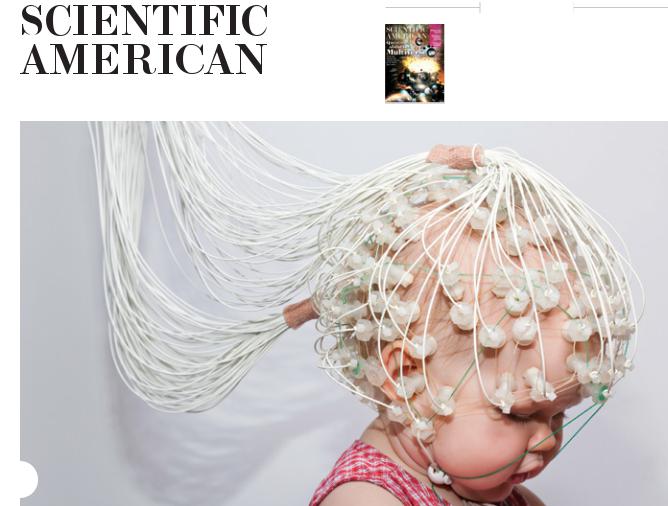
August 2011 Volume 305, Number 2
50
FEATURES
COSMOLOGY
38 Does the Multiverse Really Exist?
The answer could be unknowable. By George F. R. Ellis
HUMAN ORIGINS
44 The Evolution of Grandparents
Senior citizens may have been the secret of our species’ success. By Rachel Caspari
NEUROSCIENCE
50 How to Build a Better Learner
Brain studies suggest new ways to improve reading, writing, arithmetic—and even social skills.
By Gary Stix
ENERGY
58 The False Promise of Biofuels
They were to save us from our dependence on oil, but the breakthroughs are not forthcoming.
By David Biello
LIFE SCIENCE
66 Treasure in the Trees
Birds’ nests offer clues about natural history, climate change and their owners’ mating habits. By Nina Bai
2 Scientific American, August 2011
O N T H E C OV E R
Cosmologists talk about parallel universes so often and with such conviction that you might be forgiven for think ing their existence is unquestioned. Not so. Many cosmol ogists remain deeply skeptical. While acknowledging the appeal of the multiverse concept, they think it is un proved—and probably unprovable. Illustration by Kenn Brown, Mondolithic Studios.
MEDICINE
68 A Breath of Fresh Air
Fundamental understanding of basic biology has set the stage for new treatments for cystic fibrosis.
By Steven M. Rowe, J. P. Clancy and Eric J. Sorscher
SOCIOLOGY
74 How New York Beat Crime
The Big Apple has rewritten the rules on fighting homicides, muggings and other urban ills.
By Franklin E. Zimring
PHILOSOPHY OF SCIENCE
80 Why Math Works
The answer turns on knowing whether math is invented or discovered.
By Mario Livio
ARCHAEOLOGY
84 Guardian of the Pharoahs
Egypt’s minister of antiquities has a personal history every bit as tumultuous as his country’s recent past.
Interview by Jeffrey Bartholet
Photograph by Andrew Hetherington
© 2011 Scientific American

Advanced Hamamatsu sensors
traveled billions of miles to
analyze an asteroid surface...
Surface analysis via opto semiconductors
Last year the Japanese spacecraft Hyabusa returned from a seven-year mission to study the asteroid Itokawa. But long before it returned with material samples Hayabusa had already
extracted much information from solar
light and X-rays that
reflected
from the asteroid surface...
An onboard near infrared
spectrometer system used Hamamatsu's InGaAs image sensor to identify minerals like pyroxene and olivine on the asteroid's surface.
And a fluorescent X-ray spectrometer system employed a Hamamatsu CCD image sensor to
Hamamatsu is opening
the new frontiers
of Light 


determine chemical composition, to recognize magnesium, aluminum, silicon and more.
In this long journey, with its rapid temperature changes and harsh,
near-vacuum conditions, the sensors proved their
reliability. And also their leading-edge technology.
And that may be why Hamamatsu opto semiconductors are chosen for a broad spectrum of applications—in everything from X-ray astronomy to precise dental imaging, and everywhere from laboratories to production lines... Always seeking to open the new frontiers of light!
http://jp.hamamatsu.com/en/rd/publication/
The Hayabusa spacecraft, launched by the Japan Aerospace Exploration Agency (JAXA) in 2003, made a round trip of over six billion kilometers to the asteroid Itokawa to optically analyze its surface composition and also bring back physical samples.
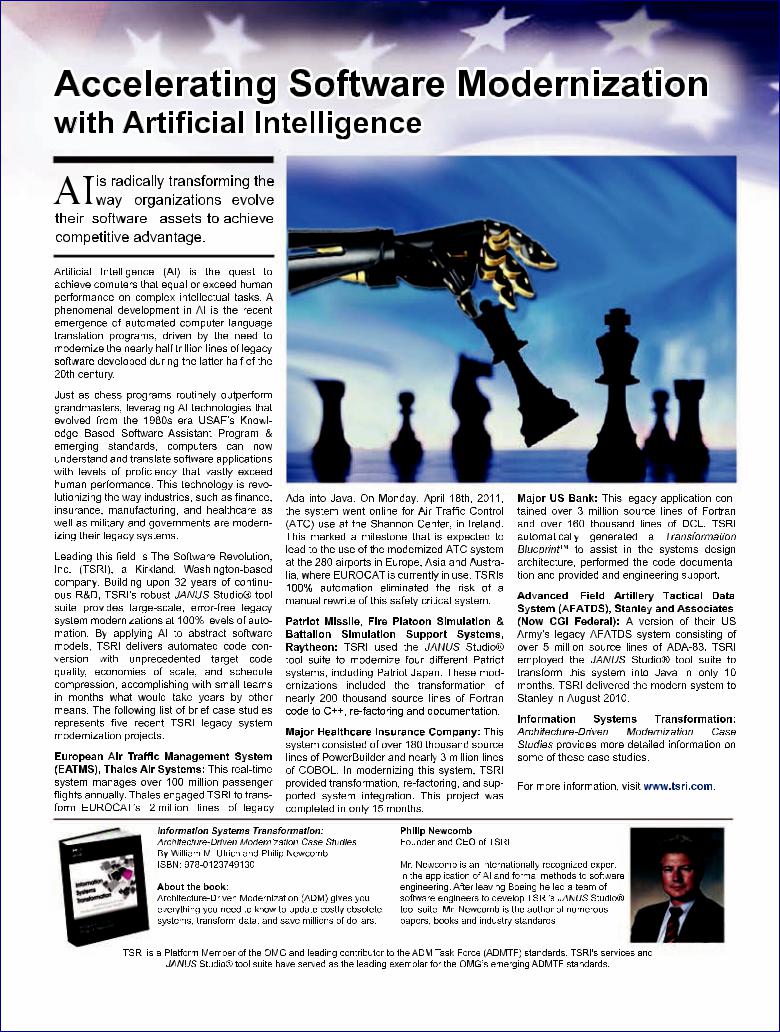
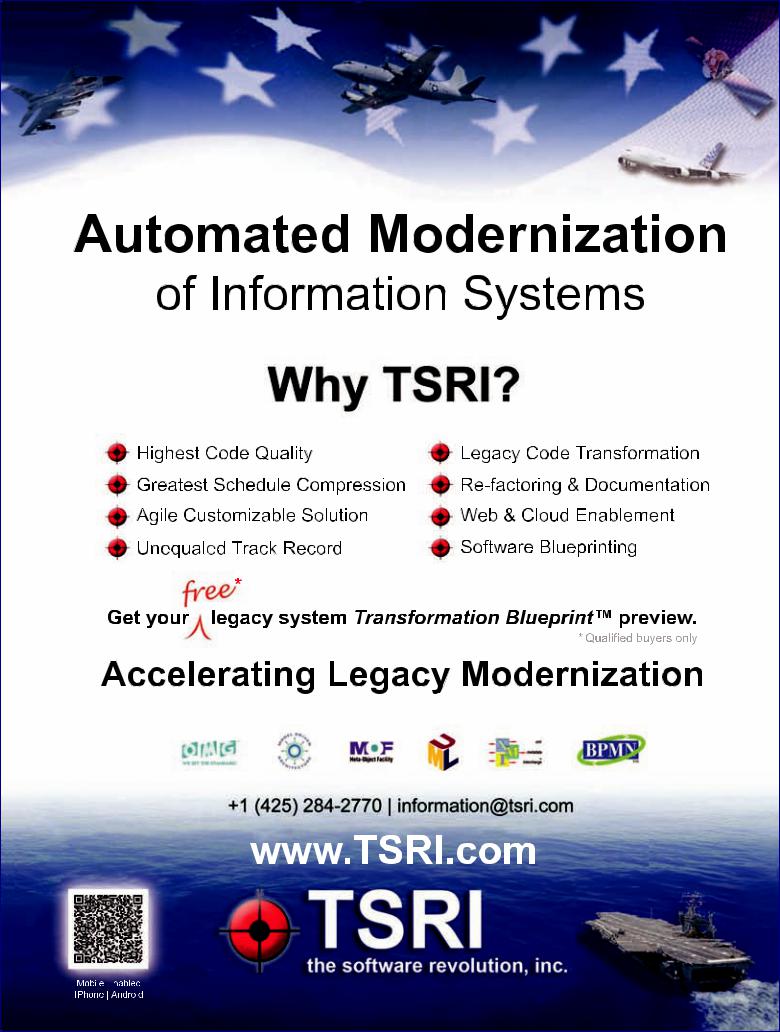
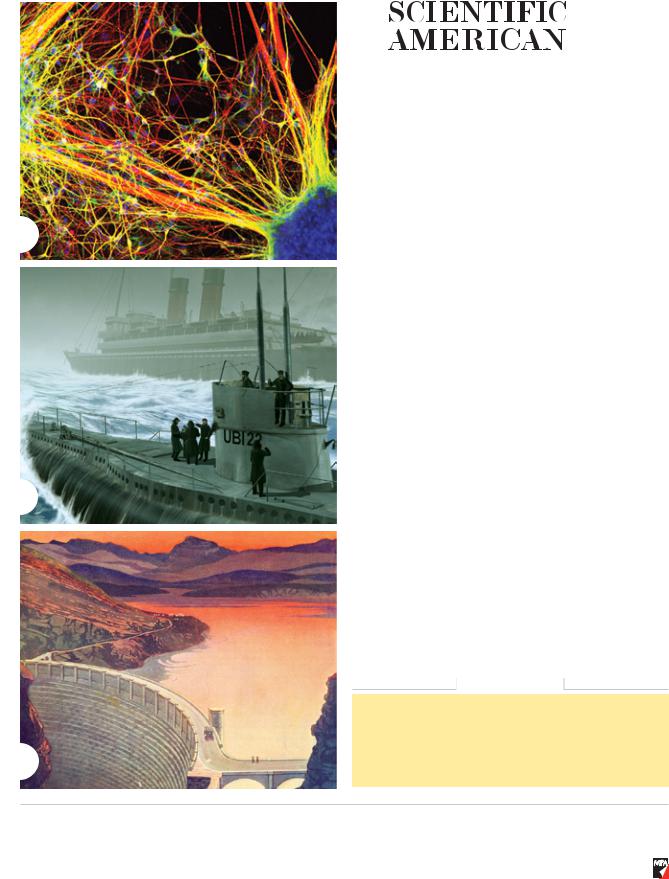
18
88
94
DEPARTMENTS
8 From the Editor
10 Letters
14 Science Agenda
Excellent science teachers are a necessity, not a luxury. By the Editors
16 Forum
Relying on individual companies to develop new drugs for mental illness no longer works.
By Kenneth I. Kaitin and Christopher P. Milne
18 Advances
Neurons in a dish. Reindeer vision. Ageless stars. Volcano electricity. Peer review in public. An E. coli scare. Dragonfish science. Where house cats roam.
32 The Science of Health
An unorthodox explanation for cancer’s origins could lead to better therapies. By Cassandra Willyard
36 TechnoFiles
The perils of copy protection. By David Pogue
88 Recommended
Silent killers: submarines. The links between leadership and mental illness. By Kate Wong
90 Skeptic
The globaloney factor. By Michael Shermer
92 Anti Gravity
Children of the multiverse say the darndest things.
By Steve Mirsky
94 50, 100 & 150 Years Ago
96 Graphic Science
The crowded ether. By Mark Fischetti
ON THE WEB
Nobelists Greet the Next Generation
The annual Lindau meeting in Germany brings together Nobel laureates with young researchers from around the world. This year’s meeting focused on physiology and
medicine. Go to www.ScientificAmerican.com/aug2011/lindau
ScientificAmerican(ISSN0036-8733),Volume305,Number2,August2011,publishedmonthlybyScientificAmerican,adivisionofNatureAmerica,Inc.,75VarickStreet,9thFloor,NewYork,N.Y.10013-1917.Periodicalspostage paid at New York, N.Y., and at additional mailing offices. Canada Post International Publications Mail (Canadian Distribution) Sales Agreement No. 40012504. Canadian BN No. 127387652RT; QST No. Q1015332537. Publication Mail Agreement #40012504. Return undeliverable mail to Scientific American, P.O. Box 819, Stn Main, Markham, ON L3P 8A2. Individual Subscription rates: 1 year $39.97 (USD), Canada $49.97 (USD), International $61 (USD). Institutional Subscription rates: SchoolsandPublicLibraries:1year$69(USD),Canada$74(USD),International$81(USD).BusinessesandColleges/Universities:1year$299(USD),Canada$304(USD),International$311(USD). Postmaster:SendaddresschangestoScientificAmerican,Box3187,Harlan,Iowa51537.Reprints available: writeReprintDepartment,ScientificAmerican,75VarickStreet,9thFloor,NewYork,N.Y.10013-1917;fax:
646-563-7138;reprints@SciAm.com. Subscription inquiries: U.S. and Canada (800) 333-1199; other (515) 248-7684. Send e-mail to sacust@sciam.com. PrintedinU.S.A. Copyright©2011byScientificAmerican,adivisionofNatureAmerica,Inc.Allrightsreserved.
6 Scientific American, August 2011
© 2011 Scientific American

Your music
never sounded
so good.
QuietComfort® 15
Acoustic Noise Cancelling® headphones
Welcome to a better sounding world, where your music comes alive as never before. The QC®15 headphones are our best, with Bose® technologies that deliver sound more naturally than conventional headphones. And a significant improvement in the noise reduction helps you focus on each nuance of your music, as distractions fade into the background. Seth Porges reports in Popular Mechanics that “Compared to the competition…the QC15s are vastly superior.” It’s a difference you need to hear to believe. We’re so sure you’ll be delighted, we’ll even pay to ship them to your door.
To learn more: 1-800-760-2749, ext. Q8335
Bose.com/headphones
©2011 Bose Corporation. The distinctive design of the headphone oval ring is a trademark of Bose Corporation. Quote reprinted with permission.

From the Editor
A Future with Science
Mariette DiChristina is editor in chief of ScientificAmerican.Find her on Twitter @SAeditorinchief
Adecade after the fall of the soviet union in 1991, modernization is the watchword in Russia—with science as a vital means to that end. During the spring meeting of the 14 international editions of Scientific American, we gathered in Moscow, and
our hosts introduced us to many of the surrounding issues. Scientific American has had a long history in this country,
where it has been available in translation for 28 years. The edition’s head, Sergei Kapitza, is a beloved researcher, science popularizer and TV personality—the Carl Sagan of Russia. When the Soviet system unraveled, however, science took a backseat to other domestic matters. Researchers lost funding and social status, crippling the former science powerhouse. Up to 35,000 scientists emigrated—a loss that the government is now trying to rectify with targeted programs.
The state-owned venture capital company Russian Corporation of Nanotechnologies, or Rusnano, will spend some 318 billion rubles (around $11 billion) in public-private partnerships aimed at creating a self-sustaining nanotech industry by 2015. (Today Russia’s nanotech products account for just 2 percent of the global market.) “Our role is to build this bridge [between science and business] and to start up the Russian nanotechnology industry,” Anatoly Chubais, CEO of Rusnano, told the Scientific American visitors. Of some 2,000 applicants, Rusnano has so far chosen to help fund 111 companies to build manufacturing facilities.
In an initiative to entice expatriates and foreign scientists to conduct basic research in Russia, the government recently set up a
Members of Scientific American’s 14 international editions came together this spring in Russia.
system of “mega grants” totaling 12 billion rubles (about $433 million). The money will help, but Russian science still suffers from the challenges of low pay and stifling bureaucracy, as Vladimir E. Fortov, academician of the Russian Academy of Sciences, explained to me. Scientists need to fill out multiple forms to get basic tools, hindering progress, and technology transfer is difficult.
Despite the problems, Russia has rightly realized that future prosperity will come from fostering science in the present, and it is devoting significant funds toward that goal. It is a lesson that the budget-sensitive U.S., which has long benefited from earlier investment in basic research, should reflect on as well. 
BOARD OF ADVISERS
Leslie C. Aiello
President, Wenner-Gren Foundation
for Anthropological Research
Roger Bingham
Co-Founder and Director,
The Science Network
G. Steven Burrill
CEO, Burrill & Company
Arthur Caplan
Emanuel and Robert Hart Professor
of Bioethics, University of Pennsylvania
George M. Church
Director, Center for Computational
Genetics, Harvard Medical School
Rita Colwell
Distinguished Professor, University of
Maryland College Park and Johns Hopkins
Bloomberg School of Public Health
Drew Endy
Professor of Bioengineering,
Stanford University
Ed Felten
Director, Center for Information
Technology Policy, Princeton University
Kaigham J. Gabriel
Deputy Director , Defense Advanced
Research Projects Agency
Michael S. Gazzaniga
Director, Sage Center for the Study of Mind,
University of California, Santa Barbara
David Gross
Frederick W. Gluck
Professor of Theoretical Physics, University of California, Santa Barbara (Nobel Prize in Physics, 2004)
Lene Vestergaard Hau
Mallinckrodt Professor of Physics and of Applied Physics, Harvard University
Danny Hillis
Co-chairman, Applied Minds
Daniel M. Kammen
Director, Renewable and Appropriate Energy Laboratory, University of California, Berkeley
Vinod Khosla
Founder, Khosla Ventures
Christof Koch
Lois and Victor Troendle Professor of Cognitive and Behavioral Biology,
California Institute of Technology, and CSO, Allen Institute for Brain Science
Lawrence M. Krauss
Director, Origins Initiative, Arizona State University
Morten L. Kringelbach
Director, Hedonia: TrygFonden Research Group, University of Oxford and University of Aarhus
8 Scientific American, August 2011
Steven Kyle |
Carolyn Porco |
|
Professor of Applied Economics and |
Leader, Cassini Imaging Science |
|
Management, Cornell University |
Team, and Director, CICLOPS, |
|
Robert S. Langer |
Space Science Institute |
|
Vilayanur S. Ramachandran |
||
David H. Koch Institute Professor, |
||
Massachusetts Institute of Technology |
Director, Center for |
|
Lawrence Lessig |
Brain and Cognition, |
|
University of California, |
||
Professor, Harvard Law School |
||
San Diego |
||
|
||
Ernest J. Moniz |
Lisa Randall |
|
Cecil and Ida Green |
||
Professor of Physics, |
||
Distinguished Professor, |
||
Harvard University |
||
Massachusetts Institute |
||
Martin Rees |
||
of Technology |
||
John P. Moore |
Professor of Cosmology |
|
and Astrophysics, |
||
Professor of Microbiology and |
||
University of Cambridge |
||
Immunology, Weill Medical |
||
John Reganold |
||
College of Cornell University |
||
Regents Professor of Soil Science, |
||
M. Granger Morgan |
||
Washington State University |
||
Professor and Head of |
JeffreyD.Sachs |
|
Engineering and Public Policy, |
||
Director, The Earth Institute, |
||
Carnegie Mellon University |
||
Columbia University |
||
Miguel Nicolelis |
||
Eugenie Scott |
||
Co-director, Center for |
||
Executive Director, |
||
Neuroengineering, Duke University |
||
National Center for |
||
Martin Nowak |
||
Science Education |
||
Director, Program for Evolutionary |
Terry Sejnowski |
|
Dynamics, Harvard University |
||
Professor and Laboratory |
||
Robert Palazzo |
||
Head of Computational |
||
Provost and Professor of Biology, |
Neurobiology Laboratory, |
|
Rensselaer Polytechnic Institute |
Salk Institute for Biological Studies |
Michael Shermer
Publisher, Skeptic magazine
Michael Snyder
Professor of Genetics, Stanford
University School of Medicine
Michael E. Webber
Associate Director, Center for
International Energy & Environmental
Policy, University of Texas at Austin
Steven Weinberg
Director, Theory Research Group,
Department of Physics,
University of Texas at Austin
(Nobel Prize in Physics, 1979)
George M. Whitesides
Professor of Chemistry and
Chemical Biology,
Harvard University
Nathan Wolfe
Director, Global Viral
Forecasting Initiative
R. James Woolsey, Jr.
Venture Partner, VantagePoint
Venture Partners
Anton Zeilinger
Professor of Quantum Optics,
Quantum Nanophysics, Quantum
Information, University of Vienna
Jonathan Zittrain
Professor, Harvard Law School
Illustration by Nick Higgins
COURTESY OF RICHARD ZINKEN Spektrum der Wissenschaft
© 2011 Scientific American


Letters
editors@sciam.com
April 2011
RED PLANET MARS LIFE
Lawrence M. Krauss’s “Rethinking the Dream” [Forum] rightly points out that the benefits of flying humans in space have not been commensurate with the cost, especially when human flight is compared with advanced robotic or automatic systems that can do many of the same tasks at one tenth of the cost and with no risk to humans. I think this is a result of NASA’s focus on dramatic, exciting exploration and failure to create an economical, durable infrastructure. I disagree with Krauss only where he advocates one-way missions to Mars. I believe that keeping humans alive on the planet for more than a few weeks will be extremely costly.
The Martian atmosphere is very thin and contains essentially no oxygen. The average surface temperature is about –60 degrees Celsius. Humans must always be in a pressurized enclosure, with a suitable atmosphere and adequate temperature and humidity control. Unlike Earth, Mars does not have a protective magnetic field, and the thin atmosphere provides little shielding from cosmic rays. I suspect some rather heavy shielding will have to be included in any habitats, rovers, and so on.
Living off the land is, I think, absolutely ruled out on Mars, where there is no free water and what water ice there is seems to lie below the surface. To be of
“Keeping humans alive on Mars for more than a few weeks will be extremely costly.”
don peterson retired nasa astronaut
use, it would have to be collected, thawed and purified.
NASA has learned that an average human will require about five kilograms of food, water and oxygen each day and will produce an equal amount of waste. Of course, water can be recycled, oxygen can be extracted from CO2 and solid waste can be treated, but all that requires power and equipment. Solar arrays on Mars must be twice the size of Earth arrays because solar radiation is weaker (the planet is farther away from the sun). And the arrays will likely require cleaning from Martian dust. For safety reasons, there must also be redundant equipment, plus tools and spare parts for repair. Solid food cannot be recycled, and growing food would require a large, totally enclosed “hothouse.”
The habitat must have air locks to enable humans and their rovers to get in and out without depressurizing the entire living environment. Surface excursions must not go so far from the habitat that participants will not be able to walk back in case their rover breaks down. Furthermore, if a sortie lasts longer than a few hours, the rover must provide food, water and toilet facilities.
Finally, there are human considerations that do not factor directly into costs but that I think make the whole idea unfeasible. Will the colonial-nauts include a doctor? Will the habitat include clinical/hospital facilities? What about recreation? What about normal family life? What happens when the colo- nial-nauts age and die?
Most of all, why would anyone go? Don Peterson
Retired U.S. Air Force pilot and NASA astronaut El Lago, Tex.
COCKTAIL PARTY CHATTER
I am deaf in one ear, and even though my hearing is much better than most, I experience the issues described in Graham P. Collins’s “Solving the Cocktail Party Problem” every day. For me, it is only when a room is very noisy and I am struggling to comprehend the conversation that I notice the process I use to solve the cocktail party problem. My technique seems to be a combination of those mentioned in the article. As in spread-spectrum signal processing, once I know what a person sounds like, I listen for the sounds he or she is making. Second, I take in the sounds and try to reconstruct the words based on the expected probability of sounds surrounding each one. Finally, I use the probability of words surrounding each one based on the context to fill in the sentence. I knit the sounds into words and the words into a sentence.
This procedure is imprecise and adds a time delay. It is very common for me to knit a sentence together several seconds after everyone else heard it. Everyone laughs, and seconds later I get to “hear” the punch line in my head. Having to do all this processing does have an upside. Sometimes the combination of words that my mind has rejected sounds like what was said and has a message that is related to the topic but creates an absurd vision in my head. Periodically the incorrect interpretation of the sounds is more entertaining than what was actually said.
Kee Nethery
Berkeley, Calif.
BIOTECH FOOD AND DRUGS
Both Brendan Borrell’s interview with agro-research czar Roger Beachy [“Food Fight”] and Mary McKenna’s “The Enemy Within” point to a serious disconnect between research, learning and hopes for applications of that research. Beachy says that crops with permanent resistance to pests are “almost unheard of,” and McKenna shows us how scary the future of infection may be with antibioticresistant bacteria winning over the development of new medicines. There is no difference between the loss of valuable antibiotics to ever more resistant bacteria and the fight with pests through ge-
10 Scientific American, August 2011
© 2011 Scientific American
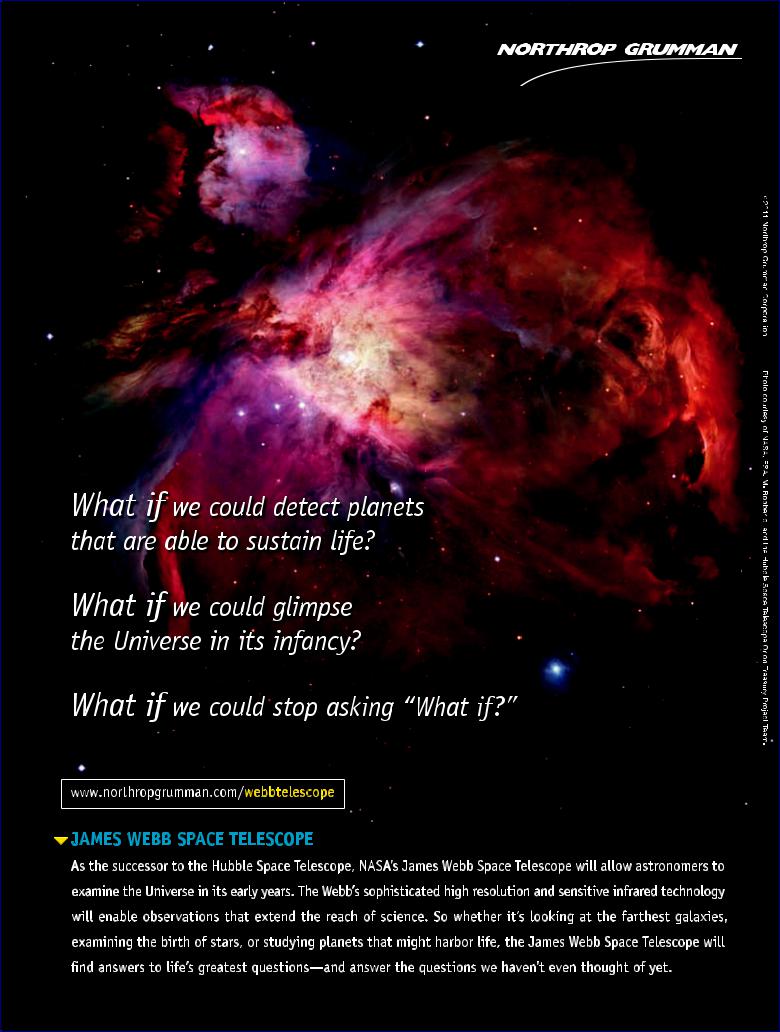

Letters
netic engineering. In only a few years, with the planet’s food-production capability more strained by population demands, major crop harvests may well follow the same hazardous, on-the-edge life we humans are walking ourselves into as a result of not learning our lessons from history nor from one another.
Scott C. Reuman
Nederland, Colo.
FAMILY ALBUMS
OF THE FUTURE
David Pogue laments in “Seeing Forever” [TechnoFiles] that current digital media may not last long. And it is good that in 100 years 99.9 percent of all images, video and audio recordings will be gone. Who cares about Uncle Joe’s photos from his 2005 vacation in Florida or Italy? Future generations need their own memories plus the very best from past generations. Nobody in the year 2100 will have the time to look at pictures from their forebears of the past 100 years. They need to build their own memories.
Marc Tomaszewski
Friedrichshafen, Germany
LIVING DREAM
Eitan Haddok’s “Can the Dead Sea Live?” shows how pragmatism can give hope. A project involving salvation of an extraordinary body of water brings together three politically disparate regions: Israel, Jordan and the Palestinian Authority. It is a rare example of cooperation in the midst of a bitter area of human conflict. An organization that has been monitoring the project, Friends of the Earth Middle East, consists of participants from each of those regions. The organization, and specifically its undertaking to save the Dead Sea, is a wonderful example of how the effort to save a precious resource can raise people above endless, vicious political squabbling.
Stanley P. Santire
Houston
ERRATUM
“Can the Dead Sea Live?” by Eitan Haddok, described a plan that would inject 1.1 million cubic meters of briny water into the Dead Sea; in fact, the amount would be 1.1 billion cubic meters.
12 Scientific American, August 2011
ESTABLISHED 1845 |
|
|
|
|
|
|
|
|
|
Editor in Chief |
|
|
|
|
|
|
|
|
|
Mariette DiChristina |
|
|
|
|
|
|
|
||
Executive |
Managing |
Managing |
Design |
||||||
Editor |
Editor |
|
|
|
Editor, Online |
Director |
|||
Fred Guterl |
Ricki L. Rusting |
Philip M. Yam |
Michael Mrak |
||||||
Senior Writer |
|
|
|
|
NewsEditor,Online |
|
|
||
Gary Stix |
|
|
|
|
Robin Lloyd |
|
|
|
|
Editors |
|
|
|
|
Podcast Editor |
|
|
|
|
Davide Castelvecchi, |
|
|
|
Steve Mirsky |
|
|
|||
Mark Fischetti, |
|
|
|
|
Associate Editors, Online |
|
|
||
Christine Gorman, |
|
|
|
|
David Biello, |
|
|
|
|
Anna Kuchment, |
|
|
|
|
Larry Greenemeier |
|
|
||
Michael Moyer, |
|
|
|
|
NewsReporters,Online |
|
|
||
George Musser, |
|
|
|
|
|
|
|||
|
|
|
|
Katherine Harmon, |
|
|
|||
Kate Wong |
|
|
|
|
|
|
|||
|
|
|
|
John Matson |
|
|
|||
Contributing Editors |
|
|
|
|
|
|
|||
|
|
|
|
Blogs Editor |
|
|
|
||
Mark Alpert, |
|
|
|
|
Bora Zivkovic |
|
|
||
Steven Ashley, |
|
|
|
|
Art Director, Online |
|
|
||
Graham P. Collins, |
|
|
|
|
|
|
|||
|
|
|
|
Ryan Reid |
|
|
|
||
John Rennie, |
|
|
|
|
|
|
|
||
|
|
|
|
Copy Editor, Online |
|
|
|||
Sarah Simpson |
|
|
|
|
|
|
|||
|
|
|
|
Michael Battaglia |
|
|
|||
Editorial Product Manager |
|
|
|
|
|
||||
|
|
|
Online Contributor |
|
|
||||
Angela Cesaro |
|
|
|
|
|
|
|||
|
|
|
|
Christie Nicholson |
|
|
|||
WebProductionEditor |
|
|
|
|
|
|
|||
|
|
|
|
|
|
|
|
||
Kerrissa Lynch |
|
|
|
|
|
|
|
|
|
Art Director |
|
Assistant Photo Editor |
Information Graphics |
||||||
Ian Brown |
|
Ann Chin |
|
Consultant |
|||||
Art Director, |
|
Managing Production |
Bryan Christie |
||||||
Information Graphics |
|
Editor |
|
Art Contributors |
|||||
Jen Christiansen |
|
Richard Hunt |
Edward Bell, |
||||||
Photography Editor |
|
Senior Production Editor |
Caitlin Choi, |
||||||
Monica Bradley |
|
Michelle Wright |
Nick Higgins |
||||||
Copy Director |
|
Senior Copy Editor |
Copy Editor |
||||||
Maria-Christina Keller |
DanielC.Schlenoff |
Aaron Shattuck |
|||||||
Editorial Administrator |
|
|
|
|
Senior Secretary |
|
|
||
Avonelle Wing |
|
|
|
|
Maya Harty |
|
|
||
|
|
|
|
|
|
|
|||
Production Manager |
|
Prepress and |
|
Custom |
|
|
|||
Christina Hippeli |
|
Quality Manager |
Publishing Manager |
||||||
Advertising |
|
Silvia De Santis |
Madelyn Keyes-Milch |
||||||
Production Manager |
|
|
|
|
|
Production Coordinator |
|||
Carl Cherebin |
|
|
|
|
|
Lisa Headley |
|||
|
|
|
|
|
|
|
|
|
|
President |
|
|
|
|
|
|
|
|
|
Steven Inchcoombe |
|
|
|
|
|
|
|
||
|
|
|
|
|
|
||||
Executive Vice President |
|
|
|
Sales Development Manager |
|||||
Michael Florek |
|
|
|
|
David Tirpack |
|
|
||
Vice President and Publisher |
|
|
|
Promotion Manager |
|
|
|||
Bruce Brandfon |
|
|
|
|
Diane Schube |
|
|
||
Vice President and Associate Publisher, |
Promotion Art Director |
|
|
||||||
Marketing and Business Development |
Maria Cruz-Lord |
|
|
||||||
Michael Voss |
|
|
|
|
Marketing Research Director |
||||
Vice President, Digital Solutions |
|||||||||
Rick Simone |
|
|
|||||||
Wendy Elman |
|
|
|
|
Sales Representative |
|
|
||
Managing Director, Consumer Marketing |
|
|
|||||||
Chantel Arroyo |
|
|
|||||||
Christian Dorbandt |
|
|
|
|
|
|
|||
|
|
|
|
Director, Ancillary Products |
|||||
Senior Marketing Manager/Retention |
|||||||||
Diane McGarvey |
|
|
|||||||
Catherine Bussey |
|
|
|
|
|
|
|||
|
|
|
|
Custom Publishing Editor |
|||||
Senior Marketing Manager, Online |
|||||||||
Lisa Pallatroni |
|
|
|||||||
David Courage |
|
|
|
|
|
|
|||
|
|
|
|
Online Associate Director |
|||||
Senior Marketing Manager/Acquisition |
|||||||||
Mike Kelly |
|
|
|
||||||
Patricia Elliott |
|
|
|
|
|
|
|
||
|
|
|
|
Online Associate Marketing Manager |
|||||
Director, Global Media Solutions |
|||||||||
Carey Tse |
|
|
|
||||||
Jeremy A. Abbate |
|
|
|
|
|
|
|
||
Manager, Integrated Media Sales |
Online Marketing Product Manager |
||||||||
Stan Schmidt |
|
|
|
|
Zoya Lysack |
|
|
|
|
Winner of the 2011
National Magazine
Award for General
Excellence
L E T T E R S TO T H E E D I TO R
ScientificAmerican 75Varick Street,9th Floor NewYork,NY10013-1917 or editors@sciam.com
Letters may be edited for length and clarity.
We regret that we cannot answer each one.
Post a comment on any article at
ScientificAmerican.com/aug2011
HOW TO CONTACT US
Subscriptions
For new subscriptions, renewals, gifts, payments, and changes of address:
U.S. and Canada, 800-333-1199; outside North America, 515-248-7684 or www.ScientificAmerican.com
Submissions
Tosubmitarticleproposals,followthe guidelinesatwww.ScientificAmerican.com. Click on “Contact Us.” We cannot
return and are not responsible for materials delivered to our office.
Reprints
To order bulk reprints of articles (minimum of 1,000 copies): Reprint Department, ScientificAmerican,75VarickStreet,
9thFloor,NewYork,NY10013-1917; 212-451-8877;reprints@SciAm.com.
Forsinglecopiesofbackissues:800-333-1199.
Permissions
For permission to copy or reuse material: Permissions Department,
ScientificAmerican,75VarickStreet, 9thFloor,NewYork,NY10013-1917; randp@SciAm.com;
www.ScientificAmerican.com/permissions. Pleaseallowthreetosixweeksforprocessing.
Advertising www.ScientificAmerican.comhas electronic contact information for sales representativesofScientificAmericanin
all regions of the U.S. and in other countries.
ScientificAmericanis a trademark of
ScientificAmerican,Inc.,usedwithpermission.
© 2011 Scientific American

|
|
|
|
|
|
I |
|
|
|
|
|
|
|
|
|
|
|
D |
T M |
|
|
|
|
|
|
|
|
|
T |
|
E |
O |
|
|
|
|
||
|
|
I |
E |
|
|
F |
|
|
|
|||
|
|
M |
|
|
|
|
|
|
F |
|
|
|
|
|
|
|
|
|
|
|
R |
||||
L |
I |
|
|
|
|
|
|
|
E |
|
||
|
70% |
|
|
|
||||||||
|
|
|
|
|
||||||||
|
|
|
|
|
3 |
|||||||
|
|
|
|
|
off |
|
|
|
|
|||
O |
|
|
|
|
|
|
R |
2 |
||||
R |
|
|
|
|
|
|
|
E |
|
|||
D |
|
|
|
|
|
|
B |
|
|
|||
|
|
E |
|
|
|
|
|
|
|
|
||
|
|
R |
B |
|
|
EM |
|
|
|
|||
|
|
|
|
|
T |
|
|
|
|
|||
|
|
|
|
|
Y |
|
|
|
|
|
||
|
|
|
|
|
|
SEP |
|
|
|
|
|
|
Get a Grip on Calculus
Calculus has made it possible to build bridges that span miles of river, to travel to the moon, and to predict patterns of population change. Yet for all its computational power, calculus is the exploration of just two ideas—the derivative and the integral— both of which arise from a commonsense analysis of motion. Master them and open a new world for yourself!
So why didn’t you grasp calculus the first time? In school, many of us didn’t continue with mathematics, and so this great achievement remains a closed door. And for those of us who did, award-winning Professor Michael Starbird—coauthor of the acclaimed math book for nonmathematicians, The Heart of Mathematics: An invitation to effective thinking—can correct the clumsy classroom delivery that hid its beauty. In Change and Motion: Calculus Made Clear, 2nd Edition, the concepts and insights at the heart of calculus take center stage.
O er expires 09/23/11
1-800-832-2412
. . /2
Change and Motion:
Calculus Made
Clear, 2nd Edition
Taught by Professor Michael Starbird







1.Two Ideas, Vast Implications
2.Stop Sign Crime—The First Idea of Calculus—The Derivative
3.Another Car, Another Crime—The Second Idea of Calculus—The Integral
4.The Fundamental Theorem of Calculus
5.Visualizing the Derivative—Slopes
6.Derivatives the Easy Way— Symbol Pushing
7.Abstracting the Derivative— Circles and Belts
8.Circles, Pyramids, Cones, and Spheres
9.Archimedes and the Tractrix
10.The Integral and the Fundamental Theorem
11.Abstracting the Integral— Pyramids and Dams
12.Bu on’s Needle or π from Breadsticks
13.Achilles, Tortoises, Limits, and Continuity
14.Calculators and Approximations
15.The Best of All Possible Worlds—Optimization
16.Economics and Architecture
17.Galileo, Newton, and Baseball
18.Getting o the Line—Motion in Space
19.Mountain Slopes and Tangent Planes
20.Several Variables—Volumes Galore
21.The Fundamental Theorem Extended
22.Fields of Arrows—Di erential Equations
23.Owls, Rats, Waves, and Guitars
24.Calculus Everywhere
Change and Motion:
Calculus Made Clear, 2nd Edition
Course no. 177 | 24 lectures (30 minutes/lecture)
SAVE $185
DVD $254.95 NOW



+$10 Shipping, Processing, and Lifetime Satisfaction Guarantee
Priority Code: 51349
Designed to meet the demand for lifelong learning, The Great Courses is a highly popular series of audio and video lectures led by top professors and experts. Each of our more than 300 courses is an intellectually engaging experience that will change how you think about the world. Since 1990,
over 9 million courses have been sold.
